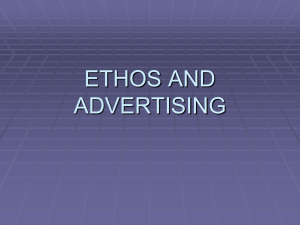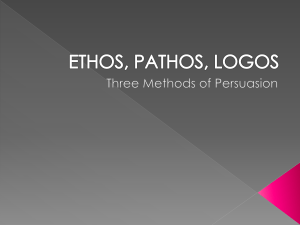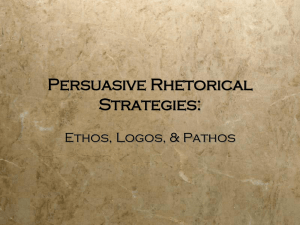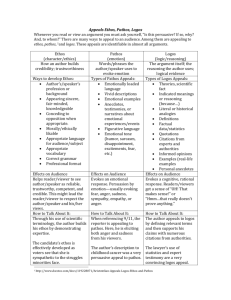File
advertisement
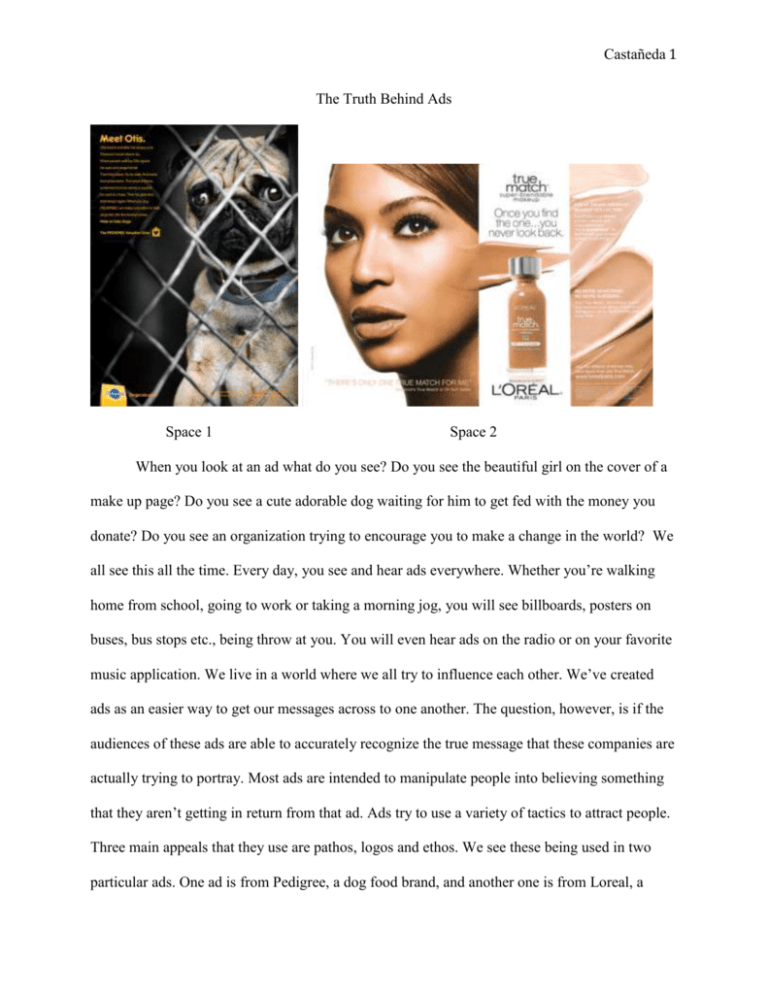
Castañeda 1 The Truth Behind Ads Space 1 Space 2 When you look at an ad what do you see? Do you see the beautiful girl on the cover of a make up page? Do you see a cute adorable dog waiting for him to get fed with the money you donate? Do you see an organization trying to encourage you to make a change in the world? We all see this all the time. Every day, you see and hear ads everywhere. Whether you’re walking home from school, going to work or taking a morning jog, you will see billboards, posters on buses, bus stops etc., being throw at you. You will even hear ads on the radio or on your favorite music application. We live in a world where we all try to influence each other. We’ve created ads as an easier way to get our messages across to one another. The question, however, is if the audiences of these ads are able to accurately recognize the true message that these companies are actually trying to portray. Most ads are intended to manipulate people into believing something that they aren’t getting in return from that ad. Ads try to use a variety of tactics to attract people. Three main appeals that they use are pathos, logos and ethos. We see these being used in two particular ads. One ad is from Pedigree, a dog food brand, and another one is from Loreal, a Castañeda 2 beauty brand. Both of these ads use a similar approach to attract people’s. Although the Loreal advertisement grabs the viewers attention through ethos by displaying Beyonce, a well-known world-wide singer, the Pedigree advertisement is more successful overall, as it uses both logos and ethos to capture a wider audience unlike Loreal. Pathos, logos and ethos are being shown in every ad that we see. These appeals are very important because they are used in advertisements to try to attain people’s attention. The most common appeal is pathos. Pathos refers to emotions, emotions that you get from seeing an ad such as feeling sad, happy, angry, or even when an ad makes you want to burst out laughing. The article, “Emotion vs Logic in the Human Brain” states that, “The reality is that a high percentage of the time people make decisions based purely on emotion”. This has to do with our brain making decisions with our limbic system rather than the neocortex (Skellon). People will be more drawn to an ad that makes them feel emotions rather than the ad that only gives of logic and charts. Humans do it without doing it purposely. Another appeal is logos, which refers to logic behind what the ad is trying to tell you. This is through the use of facts, definitions, statistics, anecdotes, expert opinions, examples, oppositions, etc. Many ads use this to show their position in an argument. People use this information to help them make decisions. Lastly, having credibility in an ad shows ethos. Most ads use ethos by having a famous celebrity represent their product or a credible person such as a doctor or anyone who is credible to the statement that they are making. Overall, the goal for these three argumentative appeals is to persuade your audience about the value of your ideas (courses.durhamtech.edu). Castañeda 3 In the two spaces shown above, we see these three appeals being depicted. Pathos is shown mostly on Space 1. Ads that make us feel emotions are usually when we see a cute animal with sad puppy dog eyes on a cover. Pedigree has made this ad of an adorable sad puppy behind what looks like a cage or a fence to automatically catch our attention. By this, the ad is already making the reader feel bad for the puppy. As a result, this image draws in the reader’s attention and curiosity to read more about the ad. The ad titles “Meet Otis”, by this they are informing the reader of the real name of the dog, which causes attachment to it right away. In the long text on the top left, the ad tells you the story of cute little Otis. They tell you that he lives in a shelter and really has nothing to do and he misses his home. At end, they tell you that when you buy a Pedigree product, they make donations to help dogs just like him find a loving home. This instantly makes the reader feel emotions for the dog and makes the reader want to go to the store to buy Pedigree to help animals in need even if they do not own a dog. This ad proves the use of pathos. Making the audience feel bad for the animal. In space 2, we do not quiet see any pathos being used. They portray Beyonce on the cover of their ad to advertise their beauty product. To a certain type of audience it does give some sort of emotion, perhaps jealousy. This is only towards the audience that looks up to Beyonce as a role model or someone who just finds her attractive. People who admire her will probably be sad or jealous that they cannot look exactly like she does. However, this product adheres them to more of a chance to look as beautiful as she does. This ad does not use pathos in a valuable way unlike Pedigree. This ad is not trying to catch the audience attention by making Castañeda 4 them feel emotion, but instead, they are trying to get their attention by portraying someone that most people know and look up to. However, Pedigree uses pathos in a more helpful way toward their brand. The pedigree ad not only uses pathos but it also uses logos. As mentioned before, logos is when a certain ad gives you logic behind what they are saying. It might be hard to see but this ad has information on the bottom right of the poster. It is in yellow letters and it states, “Total donations from PEDIGREE consumer and trade programs to local shelters in 2008: minimum $250,000 up to $1 million. *TM Trademarks Mars. Incorporated 2008.”. by doing this in very small writing on the bottom of the ad, Pedigree is trying to show that they are not greedy and that they care more about the animals than their own credits. This gives the audience more of a warmer and more trusting feeling toward the company. In space 2, logos is not present at all. They do not give the percentage of women who have actually seen in difference with the product, or any facts as to why it will actually work. They are only relying on people wanting the product enough because of the face that it portrays rather than giving the audience a logical reason as to why buy the product. The third appeal that ads usually use is ethos. Ethos is ethics. It is when ads use a professional in the area that they are talking. According to Rick Suttle in the article, “What Are Five Advantages to Using Celebrities in Advertising?”, there are five reasons as to why ads use celebrities. They can influence customer purchases, build awareness, position a brand, attract new users, and to breath life into a falling brand as in to help a brand that is small and is trying to get big (Suttle). Popular ads that show ethics are beauty ads or clothing. Most beauty ads are promoting beauty products. Most of these products have a celebrity that most people look up to or know. For instance, for the True Match Loreal Foundation product, it is promoting foundation Castañeda 5 for every skin color. This product shows a picture of Beyonce. We all know that most people who know her find her attractive because of her looks and her many talents. It also has different colors of the foundation on the side showing that it is for every skin color. On the bottom Beyonce states, “There’s only one true match for me.”, this is promoting the product because once someone sees that she enjoys it and it works for her, they assume that it will also work for them and they will achieve the same results. This ad is demonstrating that if you buy their product, you will look as good as she does and have the talents that she has once you use it. They recognize that Beyonce is a great role model in the eyes on many people, and they capitalize on this by associating her image with their company. They do a very good job in ethos by choosing a celebrity to be the face of their product. Especially because Beyoncé is the face of colored women. This reaches to most audience because all women are different skin colors and need different foundation colors that fit theirs exactly. This product is doing very good job when it comes to that, something that other foundation products could not quiet get. In Space 1, they do not portray ethics in an efficient way. One can argue that the brand Pedigree itself can be used for ethics due to the fact that they are a dog food company and they know a lot about animals. On the other hand, they are not a notable figure in the field because all they do is make dog food products and are not organization leaders to help out animals. But for the most part, it is argumentative that it is a valuable source for ethos. Most of the time, people fall for these ads. They believe that Pedigree truly cares for the animals and is willing to give away money to help them. As heartwarming as it might sound, most of the companies that promote this are only looking after their brand. Pedigree main objective is just to maximize its sales. That is why it is using this appeal because they know that Castañeda 6 this catches more of the audiences attention. They want to give the company a good name by promoting good to other animals rather than only the domesticated dogs with a loving home. This encourages people to buy this product not knowing the real truth behind the ad. Even though there is a different reason behind why Pedigree chooses to help sheltered animals, they depict pathos and logos in a exceptional way to attain peoples attention into buying their products. Also, Loreal is not truly showing the truth behind their advertising because not everyone will look like Beyonce does or have amazing skin like she does after using their product. Companies have to use different appeals to show what they are trying to get across to the audience and hide what they are truly saying. In the article “TRUTH IN ADVERTISING: If Ads Were Brutally Honest, Here's What They'd Say”, they give examples of famous picture ads and their logos. They show what the text of the picture says and then they replace it with what they are truly trying to say. It’s very surprising to find out what is hidden behind a simple advertisement. These two examples only showed three of the many appeals that ads use to drag people into buying their products. There’s always a message behind each ad if you look closely. Appeals are a great way to catch the audiences’ attention even if they are not interested in the product. People are mostly into emotional ads, or ads that show their favorite celebrity or ads that show the logic behind it like graphs that prove the statement is correct. People that make the ads know how to catch peoples attention and they try to take an advantage of it to create ads that people will love even if they do not know what is the real meaning behind them. Therefore, the ad that uses these appeals the best is space 1. This ad uses both pathos and logos to catch a wider audiences attention. As said by Skellon, people are more oriented to choose emotions. Which exhibits that pedigree really tried to catch the audience’s attention by making them feel bad for Castañeda 7 the sad animal in the cover of their ad. At the same time, they supported their claim as to how much they have donated in the past to organizations to give animals a home by adding the text on the bottom. Space 2 mostly caught only women’s attention, since they are the ones who are into beauty products. This ad was also only aimed to people who liked Beyonce because if someone does not like her, they will most likely be repellant to buying the product. Castañeda 8 Work Cited DeGraffenreid, Michele. “Aristotle’s Three Argumentative Appeals.” English 113B: California State University, Northridge. Lecture. 26 Feb. 2015. Skellon, Nick. “Emotion vs Logic in the Human Brain.” Speak Like a Pro, N.p. Mar. 2014. Web. 20 Mar. 2015. < http://www.speaklikeapro.co.uk/Emotion_vs_Logic.htm> Stampler, Laura. "TRUTH IN ADVERTISING: If Ads Were Brutally Honest, Here's What They'd Say." Business Insider. Business Insider, Inc, 28 Apr. 2012. Web. 20 Mar. 2015. < http://www.businessinsider.com/truth-in-advertising-if-ads-were-brutally-honest-hereswhat-theyd-really-say-2012-4> Suttle, and Demand Media. “What Are Five Advantages to Using Celebrities in Advertising?” Small Business. Hearst Newspaper, n.d. Web. 20 Mar. 2015. <http://smallbusiness.chron.com/five-advantages-using-celebrities-advertising34394.html> "Ethos, Pathos, and Logos." Ethos, Pathos, and Logos. N.p., n.d. Web. 07 May 2015. <http://courses.durhamtech.edu/perkins/aris.html>
